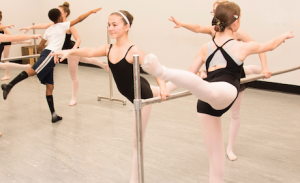Ten-year-old Laikyn started dancing at a local program in her St. Bernard neighborhood just before she turned 3. Age three is a natural time for starting your young child in dance. It was important to Laikyn’s mom, Aimee, that Laikyn try several different activities, but dance has been one that Laikyn still enjoys after several years.
If your child is interested in taking dance, it’s worth putting time and effort into finding the right program that will encourage her growth and love of movement.
So where do you begin? Word of mouth is an excellent starting point. With so many programs in our area, ask other moms with little dancers what programs and tips they may have to help get you started.
Patsy Rabinowitz, owner of West Chester Academy, where kids learn dance, music, acting, gymnastics and more, says to take a good look at your child. Is she given to twirling and spinning at home? Does she respond physically to music?
“These are both indicators that she would enjoy being in a dance class,” Rabinowitz says.
Next, in evaluating programs, start with the teachers. “Are they passionate about teaching dance and the development of their students as dancers and as growing children?” Rabinowitz asks.
Bobbi Wyatt, owner of Mason Dance Center, says, “Finding a great fit is important since many students spend multiple years growing up at a studio.”
Tour different dance facilities and observe a class if you can.
“Watch how teachers and staff interact with their students and parents,” Wyatt says. Is it a welcoming environment? Ask about the dance instructors’ training and continuing education. Some schools are more focused on a structured, disciplined dance environment while others emphasize the sheer joy of movement.
For Aimee and Laikyn, a good, relatable instructor was at the top of their list. Laikyn had the same instructor for her first four years of dance. When the teacher left to run Gotta Dance (studios in Anderson and Mt. Lookout), Laikyn followed.
“The fundamentals are taught the same way at most schools,” says Aimee, “so to me, it was all about the teacher and the relationship with my child. They know her, and she is comfortable with them,” she adds.
WHAT KIND OF DANCE?
Many dance experts suggest to start your child in ballet in order for him to learn fundamentals and basic terminology. From there, keep exposing your child to different styles of dance. Rabinowitz recommends beginning with ballet, regardless of what form of dance she might segue into.
“Ballet is the foundation for all forms of dance and it helps build your child’s core center which is important for increasing her skill set in years to come,” she says. Classes at West Chester Academy start at age 2 with the Parent & Tot program then progress to ballet and other genres that might inspire her.
“We feel if a child shows interest in a particular genre, it is our job to teach her and grow that enthusiasm,” says Rabinowitz. “Matching classes to older children’s personalities shows their individuality.”
Wyatt says that while different styles of dance attract different personalities, most little ones should start with ballet and creative movement.
“The fun role-playing in creative movement classes is great for stimulating imaginations. Tap dance is usually upbeat and fast-paced, great for developing rhythm, coordination and timing. Hip-hop is what a lot of girls gravitate to because it’s so woven into cheerleading and dance programs at schools today. Jazz and musical theater classes with pop music and show tunes attract young talents who love to move and who want to be in musicals.
For the older child, contemporary and modern dance are great for artistic expression as well as flexibility, balance and endurance. The truth is, if your child has natural rhythm, as she gets older, she will be able to weave through all the dance styles to become a well-rounded dancer.
COST CAN ADD UP
Prices can vary widely from school to school, and once you consider the costs of dancewear, costumes and travel, your expenses can add up. Travel comes in when children (and parents) make the decision to branch out into competitive dance.
As students progress and branch out into other styles jazz and tap shoes may be required. Hip-hop dancers often dance in sneakers. Most schools have a year-end or holiday performance that you’ll need tickets for. Performances also usually require the purchase of a costume — sometimes more than one if your child is in different types of dance at the same studio.
Will the expenses be worth it? Yes, if you’ve done your homework before your child begins. Aimee says Laikyn has developed coordination and grace and she’s made close friends along the way. So pay attention when your little one keeps hopping up from the dinner table to show you her latest moves. Put her in dance! Do your homework then start her off. The experience alone? Priceless.





